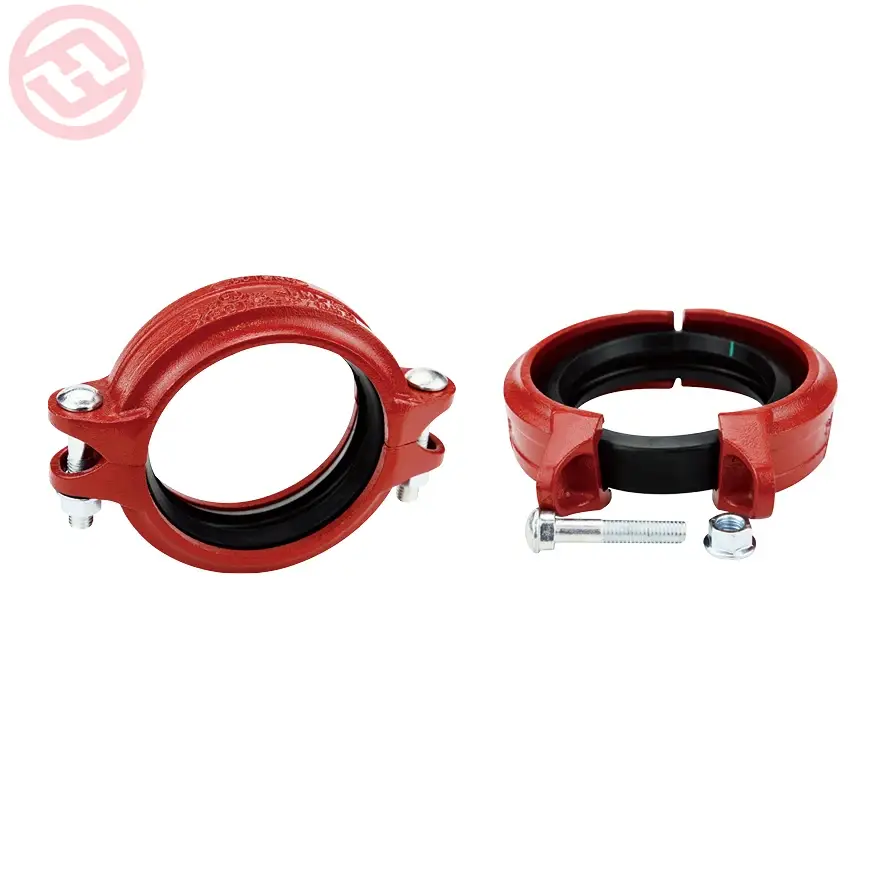Flexible Couplings come in various types, each with unique designs and characteristics tailored to specific applications.
Here are some of the main types of Flexible Couplings and their differences in terms of design and applications:
- Jaw Couplings:
- Design: Jaw couplings consist of two metal hubs with curved jaws and an elastomeric spider insert that fits between the jaws.
- Applications: They are versatile and used in a wide range of applications, including pumps, compressors, conveyors, and general machinery. They offer good flexibility and shock absorption.
- Gear Couplings:
- Design: Gear couplings use meshed gear teeth to connect the hubs, allowing for a high torque transmission capacity.
- Applications: Gear couplings are ideal for heavy-duty applications, such as rolling mills, large conveyors, and heavy machinery. They offer excellent torque transmission and misalignment tolerance.
- Elastomeric Couplings:
- Design: Elastomeric couplings use an elastomeric element, such as rubber or polyurethane, to provide flexibility.
- Applications: They are commonly used in pumps, fans, HVAC systems, and other applications that require vibration damping and moderate misalignment compensation.
- Disc Couplings:
- Design: Disc couplings use thin metal discs to connect the hubs. They offer high torsional stiffness and zero-backlash properties.
- Applications: Disc couplings are used in precision machinery, such as CNC equipment, robotics, and high-precision positioning systems, where precise alignment and low windup are critical.
- Diaphragm Couplings:
- Design: Diaphragm couplings use a series of thin metal diaphragms to transmit torque and accommodate misalignment.
- Applications: They are suitable for applications with high torque and high-speed requirements, such as turbomachinery, pumps, and precision equipment.
- Grid Couplings:
- Design: Grid couplings utilize a flexible grid element to transmit torque. The grid absorbs shock and misalignment.
- Applications: They are used in various applications, including industrial machinery, conveyors, and material handling equipment.
- Oldham Couplings:
- Design: Oldham couplings consist of three parts: two hubs and a center disc with slots and tongues. They provide axial misalignment compensation.
- Applications: Oldham couplings are used in applications with limited angular misalignment, such as stepper motors, encoders, and linear motion systems.
- Bellows Couplings:
- Design: Bellows couplings feature a thin-walled, accordion-like bellows made of metal. They provide high torsional stiffness.
- Applications: They are used in precision equipment, optical devices, and applications that require low windup and precise motion control.
- Tire Couplings:
- Design: Tire couplings use rubber or elastomeric elements shaped like tires to connect the hubs and provide flexibility.
- Applications: They are commonly used in the mining industry, conveyors, crushers, and other applications that require shock absorption and moderate misalignment compensation.
The choice of Flexible Coupling type depends on factors such as the application’s torque requirements, misalignment tolerance, environmental conditions, and required flexibility. Each type is designed to address specific needs and provide optimal performance in its intended applications.
What advantages does a Flexible Coupling offer in terms of system stability, reduced maintenance, and extended equipment lifespan?
Flexible Couplings offer several advantages that contribute to system stability, reduced maintenance, and an extended equipment lifespan in mechanical systems. Here are some of the key benefits:
- Vibration Damping: Flexible Couplings are designed to absorb and dampen vibrations and shocks. By reducing the transmission of vibrations from one shaft to another, they contribute to smoother and quieter operation, which is essential for system stability and comfort.
- Misalignment Compensation: Flexible Couplings can accommodate angular, parallel, and axial misalignment between two shafts. Flexible Coupling This capability is vital in real-world applications where perfect alignment is often difficult to achieve. Misalignment compensation helps prevent premature wear and damage to connected equipment.
- Reduced Stress on Equipment: By allowing for misalignment compensation and vibration absorption, Flexible Couplings reduce the stress and load on connected machinery and components. This helps prevent premature wear, fatigue, and mechanical failures.
- Extended Equipment Lifespan: The reduced stress and wear on equipment result in an extended lifespan for machinery and components. This means less frequent replacement and lower long-term operating costs.
- Maintenance Reduction: With less wear and fewer maintenance requirements, Flexible Couplings reduce the need for regular maintenance and servicing. This is particularly valuable in applications where access for maintenance is challenging.
- Energy Efficiency: The reduction of vibrations and mechanical stress can lead to increased energy efficiency, as less energy is wasted on unnecessary vibrations and friction.
- Easy Installation and Replacement: Flexible Couplings are relatively easy to install and replace, which can save time and effort during maintenance or system upgrades.
- Backlash Reduction: Some Flexible Couplings, such as disc couplings, have zero-backlash properties. This is essential in applications where precise positioning or synchronization of components is required.
- Protection Against Overloads: In cases of sudden overloads or torque spikes, Flexible Couplings can help protect equipment by absorbing the excess energy and preventing damage.
- Quiet Operation: Flexible Couplings contribute to quieter operation in machinery and systems, enhancing workplace comfort and reducing noise-related health and safety concerns.
- Compatibility with Different Shaft Diameters: Many Flexible Couplings can accommodate different shaft diameters, providing versatility in design and simplifying component selection.
- Safety: In the event of an unexpected overload or jam, Flexible Couplings can help prevent catastrophic equipment failures, contributing to overall system safety.
- Environmental Adaptability: Depending on the type and material of the Flexible Coupling, they can be suitable for use in a wide range of environmental conditions, including those with temperature extremes and exposure to chemicals.
Overall, Flexible Couplings play a crucial role in promoting system stability, protecting equipment, and reducing maintenance and operational costs. Their ability to absorb vibrations and accommodate misalignment makes them invaluable in a variety of industrial and mechanical applications.

